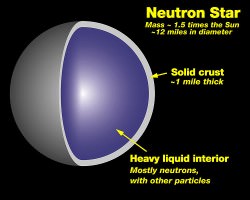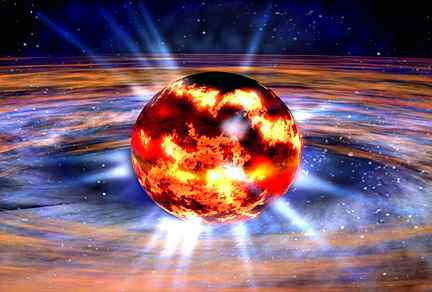[/caption]So how do you take the temperature of one of the most exotic objects in the Universe? A neutron star (~1.35 to 2.1 solar masses, measuring only 24 km across) is the remnant of a supernova after a large star has died. Although they are not massive enough become a black hole, neutron stars still accrete matter, pulling gas from a binary partner, often undergoing prolonged periods of flaring.
Fortunately, we can observe X-ray flares (using instrumentation such as Chandra), but it isn’t the flare itself that can reveal the temperature or structure of a neutron star.
At the AAS conference last week, details about the results from an X-ray observing campaign of MXB 1659-29, a quasi-persistent X-ray transient source (i.e. a neutron star that flares for long periods), revealed some fascinating insights to the physics of neutron stars, showing that as the crust of a neutron star cools, the crustal composition is revealed and the temperature of these exotic supernova remnants can be measured…
During a flare outburst, neutron stars generate X-rays. These X-ray sources can be measured and their evolution tracked. In the case of MXB 1659-29, Ed Cackett (Univ. of Michigan) used data from NASA’s Rossi X-ray Timing Explorer (RXTE) to monitor the cooling of the neutron star crust after an extended period of X-ray flaring. MXB 1659-29 flared for 2.5 years until it “turned off” in September 2001. Since then, the source was periodically observed to measure the exponential decrease in X-ray emissions.
So why is this important? After a long period of X-ray flaring, the crust of a neutron star will heat up. However, it is thought that the core of the neutron star will remain comparatively cool. When the neutron star stops flaring (as the accretion of gas, feeding the flare, shuts off), the heating source for the crust is lost. During this period of “quiescence” (no flaring), the diminishing X-ray flux from the cooling neutron star crust reveals a huge wealth of information about the characteristics of the neutron star.

Including the data from another neutron star X-ray transient KS 1731-260, the cooling rates observed during the onset of quiescence suggests these objects have well-ordered crustal lattices with very few impurities. The rapid temperature decrease (from flare to quiescence) took approximately 1.5 years to reach thermal equilibrium with the neutron star core. Further work will now be carried out using Chandra data so more information about these rapidly spinning exotic objects can be uncovered.
Suddenly, neutron stars became a little less mysterious to me in the 10 minute talk last Tuesday, I love conferences…
Related publications:
- Chandra and Swift observations of the quasi-persistent neutron star transient EXO 0748-676 in quiescence, Degenaar et al., 2008
- THE CRUST COOLING CURVE OF THE NEUTRON STAR IN MXB 1659-29, Rudy Wijnands, 2004


Hey Ethan, thanks for that 🙂 Got the brackets in the wrong place of the sentence. Corrected now!
Cheers, Ian 😀
Dave, with reference to OillsMastery: We really ought not to feed the trolls. It just encourages them. Oills ramblings are their own worst advertisement — no put-downs of them needed, because they do all the work themselves.
So now I’m just curious, what is the typical temperature of the core of a neutron star 1.5 years after a flare up (after thermal equilibrium has been reached)?
Just FYI, the mass you quoted (the range I know is a little bigger, from about 1 solar mass to about 3 solar masses) is the mass of the neutron star after the supernova explosion, not the mass of the star before it explodes.
A star really needs about, as far as I know, about 8 solar masses to go supernova and form a neutron star. But neutron stars are a lot less massive than the stars that create them!
“According to electric star theory, neutron stars belong in the same category with invisible pink unicorns.” — Stephen Smith, physicist, November 2008
According to crank theory ( and a most disturbing look at oils’s blog ), OillsMastery belongs in the same category as internet trolls, crackpots, science deniers and reality-unbelievers.
Dave, spoken with the language of a true fundamentalist. No less than 4 ad hominems and zero logical content. Well done.
Something I always wondered, the science noob I am: Suppose you could get a spoonfull of neutron star matter, what would happen to it?
Would it, once released from the crushing gravity expand to normal matter or would it stay degenerate matter?
I don’t know whether the Neutron matter would stay together (i.e., whether it is a solid at normal conditions), but the neutrons would decay with a half-life of ~15min anyway.
I, too, would like to know how hot it is then. (In Kelvin, not Fahrenheit, preferably.)
So might this go on to tell us something about ‘quark stars’?
Well the spoon of neutron star material will be the same as what we have here without the rest of the mass that generates that massive amount of gravity.
It is the combined mass of all the neutron star that makes it a neutron star. The atomes are so packed tight that their neutrons are packed on each other without any space in between.
But without the other mass of the star, it just is normal matter.
ok, you got the 1.35-2.1 solar masses, 24km d covered. what about the temperature?
let me guess. it’s between 0 and +infinity K.
The half life of an isolated neutron is 10.5 minutes when it decomposes to become a proton and an electron – a VERY hot hydrogen atom. Your teaspoon of neutrons would “burn off” for about 6 half lives. It would flare violently for about an hour, blasting radioactive hydrogen in all directions. It’d make a great bomb! Maybe take out a continent.
“Would it, once released from the crushing gravity expand to normal matter or would it stay degenerate matter?”
Yes, it would expand, and rather violently…
Some speculate that hydrogen, compressed to a metallic state would remain so, after the pressure’s removed (though still with the potential to energetically revert), but the stuff of neutron stars is an exponentially different range of density and physics, with nothing but pressure from the entire star’s gravity holding it in that state.
However, you might well find a thin crust of not-as-dense ‘degenerate matter’ (the stuff of white dwarf stars) on the surface of neutron stars.
Well oils, how bout you go counting all the logical fallacies and fundamentalist views on your blog eh? no? not such a good idea huh? thort so…
Dave, shame on you, lauging at the expense of someone that has no clue about science or physics? LOL
What does this mean for the poor Cheela?
How can you write an article about measuring the temperature of a neutron star and not mention what the measured temperature was??!!!
OIlls is right. No such thing as a neutron star.
One of these days everyone will subscribe to the EU theory. Until then, we can continue to laugh at the fact that cosmologists continue to do research on non-existent objects.
Yael & Dave: Re Trolls. I made the mistake of engaging with them on the No Geo-Mag Reversal thread and can’t get out.
Hiker 9965 Says:
January 12th, 2009 at 3:52 pm
Oh God. Not another one. Why don’t you all go and start an ‘Electric Universe Today’ website so that everyone can safely not give a sh!t about it and you guys can wax lyrical about how oppressed by the mainstream you always are. I know there wouldn’t be any actual research or results to publish, but that shouldn’t get in the way of a good half-baked theory!
Since there’s no answer about the temperature, and I’m curious too, I made a little search and calculation.
X-rays wavelengths range between 10 E-11 and 10 E-8 m:
http://en.wikipedia.org/wiki/File:EM_spectrum.svg
Thermal radiation wavelength and temperature of emitting body are linked through ‘Wien’s displacement law’:
http://en.wikipedia.org/wiki/Wien's_Law
This would give a very rough estimate somewhere between 100,000 and 100,000,000 K – that is, if I understand what I read correctly! 😉
Not exactly ‘cool’!
Ian I love you.
you have been a bit out of the business.
But these scary things like Neutrons and gravitons and X-rays mae me shiver ….again.
Oooohh do it again.
dont listen to those scientists, you are my hero.
So cool and so scary.
And yes better a good storyteller than a dry scientist.
Keep up those speculations and sensations.
boooooomm Baaaang